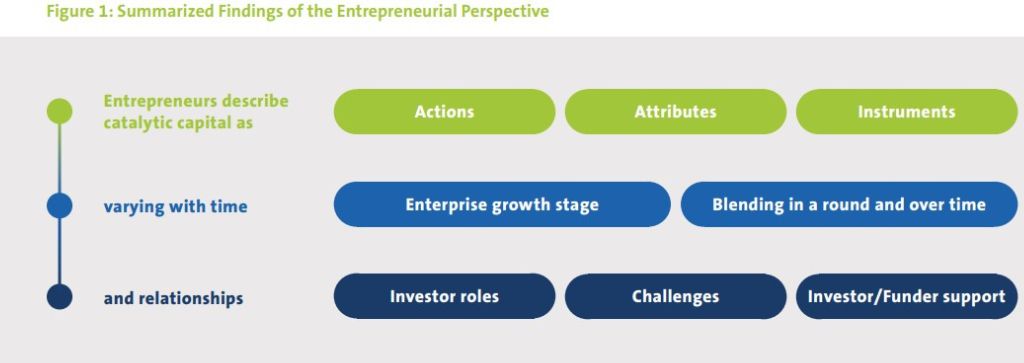In recent years, much of the attention in the impact finance sector has gone to the stewards of capital—investors, foundations, and other funders—with stakeholders across the industry wondering what drives them most and which approaches work best. Yet this one-sided focus tends to draw us away from the sector’s real purpose. Impact can’t be achieved without input from the recipients of capital: the entrepreneurs.
Most investors firmly believe that catalytic capital is the type of impact finance that entrepreneurs value most. It offers flexible terms and can attract additional capital from third parties. It accepts disproportionate risk and/or concessionary returns. It is patient and provides more innovative and tailored financing structures. And it is the most crucial part of any blended finance transaction. But since most research has only explored investors’ views on catalytic capital, we wondered whether their assumptions about its value align with entrepreneurs’ actual opinions about it. What advantages do they see in the practice of catalytic capital and blended finance? How do they feel they benefit from the development of this field? And what improvements would they like to see in the efforts of investors and other funders to support entrepreneurial impact solutions?
To help provide answers to these questions, the Initiative for Blended Finance at the University of Zurich, the Bertha Centre for Social Innovation and Entrepreneurship at the University of Cape Town, and Roots of Impact conducted research with a different perspective. With support from the Catalytic Capital Consortium, we focused on the end users of catalytic capital and asked quite provocatively: “What’s in it for the entrepreneur?”. Our goal was to learn what value they really find in this type of financing—and as a result, how these structures might be improved. To that end, we asked the following questions:
- Does catalytic capital deliver on its promise?
- Does it, in fact, catalyze?
- And what exactly are the features that enable it to help entrepreneurs deliver on their missions?

The difference between ‘just useful’ and ‘truly catalytic’ capital
Our research was based on in-depth conversations with 26 experienced entrepreneurs from different sectors in Asia, Africa, and Latin America. Each of them is driving positive change and has come up with breakthrough innovations. What we found is that they have nuanced perspectives and can describe exactly what is most catalytic and valuable to them. Yes, financing terms are important, but there are additional factors that matter a lot. Our interviewees clearly see a difference between capital that is “just useful” and capital that is “truly catalytic”. More importantly, their experience is affected by the specific characteristics and broader context of the catalytic capital provided to them.
For social entreprenuers, having a lead investor who offers shared due diligence is important.
For instance, many entrepreneurs like blending capital within single financing rounds (vertically) as well as over the entire entrepreneurial lifecycle (horizontally). And they prefer to do this by blending grants and concessionary capital with investments from a range of capital providers, including impact investors, development finance institutions and foundations. We found a lot of unexpected diversity in entrepreneurs’ experiences and opinions of catalytic capital. Yet there were some common characteristics of truly catalytic capital that stood out, which highlighted what entrepreneurs value most in these investments, including:
- Introductions to other investors and field resources.
- Collaborative investors that lead, share, simplify and/or streamline due diligence processes with co-investors.
- Capital structured to be flexible, efficient, patient, concessionary and reputable for early- and growth-stage enterprises. Also, capital that rewards outcomes and incentivizes additional capital through matching.
- Capital that is blendable within a financing round as well as over the funding lifecycle of an enterprise, which provides reasonable terms facilitated by grants, concessionary and subordinated positions, and by using tools such as convertible notes. Within a financing round, having a lead investor who offers shared due diligence and respect for the entrepreneur is important, since this streamlines the process for entrepreneurs and enables them to continue working on their businesses.
- Interconnection between capital and strategy. Entrepreneurs think of capital as a tool for developing and growing their businesses, and to that end, they must keep both their funding needs and their broader strategy aligned. Therefore, investors who also think long-term and relationally between capital and strategy are key partners.
- Long-term innovation support through grants. This support enables entrepreneurs to experiment, innovate and improve, and these grants take risks that equity investors do not want to finance, but that they expect to see from scaled enterprises.
- Relationships with investors who respect entrepreneurs’ local knowledge of impact and their vision for the enterprise and its impact strategy—and who encapsulate this respect in the terms of the capital itself. One-on-one relationships with this sort of investor are highly valuable for entrepreneurs.

What can capital providers do with these insights?
If we really care about driving positive change for people and the planet, it is essential to regularly scrutinize our assumptions. Therefore, we would like to encourage everyone in the impact field to listen carefully to what entrepreneurs have to say. As the value creators on the ground, they are the ones who make the difference.
Investors can maximize the value of their funding with actions and terms that are aligned with the company’s growth plan, timeline, and broader financing journey.
We very much hope that catalytic capital providers will review and discuss our findings, draw their individual conclusions, and put them into practice to achieve better impact. Our study is meant to be a holistic consideration of capital that can make a difference for early- and growth-stage enterprises. Since entrepreneurs connect the structure of finance raised to the broader context in which it can be catalytic, investors can maximize the value of their funding with actions and terms that are aligned with the company’s growth plan, timeline, and broader financing journey. This way, they can establish a partnership that truly supports the needs of the entrepreneurs.
While this broader context is often considered secondary, our research has made it clear that it’s actually essential: Funders must listen to and honor entrepreneurs’ viewpoints, in order to make their capital not “just useful”, but “truly catalytic”.
This article was originally published on NextBillion.





